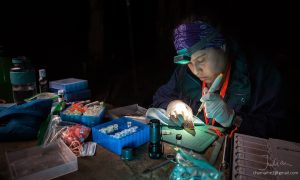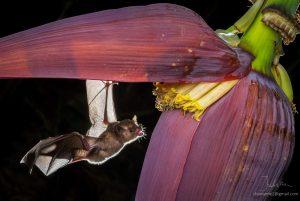In this series of posts, Carsten Brühl reports about his current trip to Costa Rica. Part 3 is all about the students Priscilla and Julian who tell us about their bat conservation efforts in agroecosystems such as banana plantations.
Yesterday I visited the University in San Jose to meet Priscilla Alpizar who is a PhD student working on bats with focus on habitat effects of banana plantations, and Julian Schneider who showed me his exceptional photos of bats. For us they both took the time to present themselves and their work in Costa Rica.
Pricilla:
As a Costa Rican tropical bat ecologist, I find the effects that agroecosystems have on wildlife to be extremely meaningful and important for conservation. I have worked with bats for over ten years and, for the last seven, I have focused my research on two of the most relevant crops for Costa Rica, banana and pineapple. Currently, I am doing my PhD in the Institute of Evolutionary Ecology and Conservation Genomics in Ulm University.
I am studying the effects that intensive banana monocultures and the associated agrochemical use have on one species of nectar-feeding bat (Glossophaga soricina, Phyllostomidae: Glossophaginae) by exploring the relations between habitat alteration, diet, gut microbiota, and immune system condition. For the past two years I have obtained pollen, fecal, and blood samples from G. soricina individuals in natural forests, organic and conventional banana plantations in the Northern-Caribbean lowlands of Costa Rica. I hope this study will provide a comprehensive insight into the dietary, physiological and immunological effects that the conversion of natural habitats to agricultural monocultures may have on local wildlife, thus providing stimuli for conservation management decisions.
Julian:
Besides studying Mathematics/CSE and Music, I have been working freelance in imaging/photography for science projects of Ulm University and the Universidad de Costa Rica in the field of biology and medicine. My work often focuses on revealing situations and processes invisible to the naked eye. Bats are specifically interesting in this aspect, since their fascinating biology and ecosystem services are seldom recognized due to the lack of images and education – often leading to some kind of “obscure vampire image” instead.
Since contact with humans (which increases in modified landscapes) tends to be an additional threat to bats, Priscilla and Julian created an environmental education program for the communities surrounding the banana plantations. Their team includes an environmental educator who helps in the development of workshops and didactic material that will improve people’s images about bats and guide them into a healthier coexistence with these animals.
You can read more about Priscilla’s research here, and have a look on Julian’s photographic projects here.



